2017年01月の記事
全6件 (6件中 1-6件目)
1
-
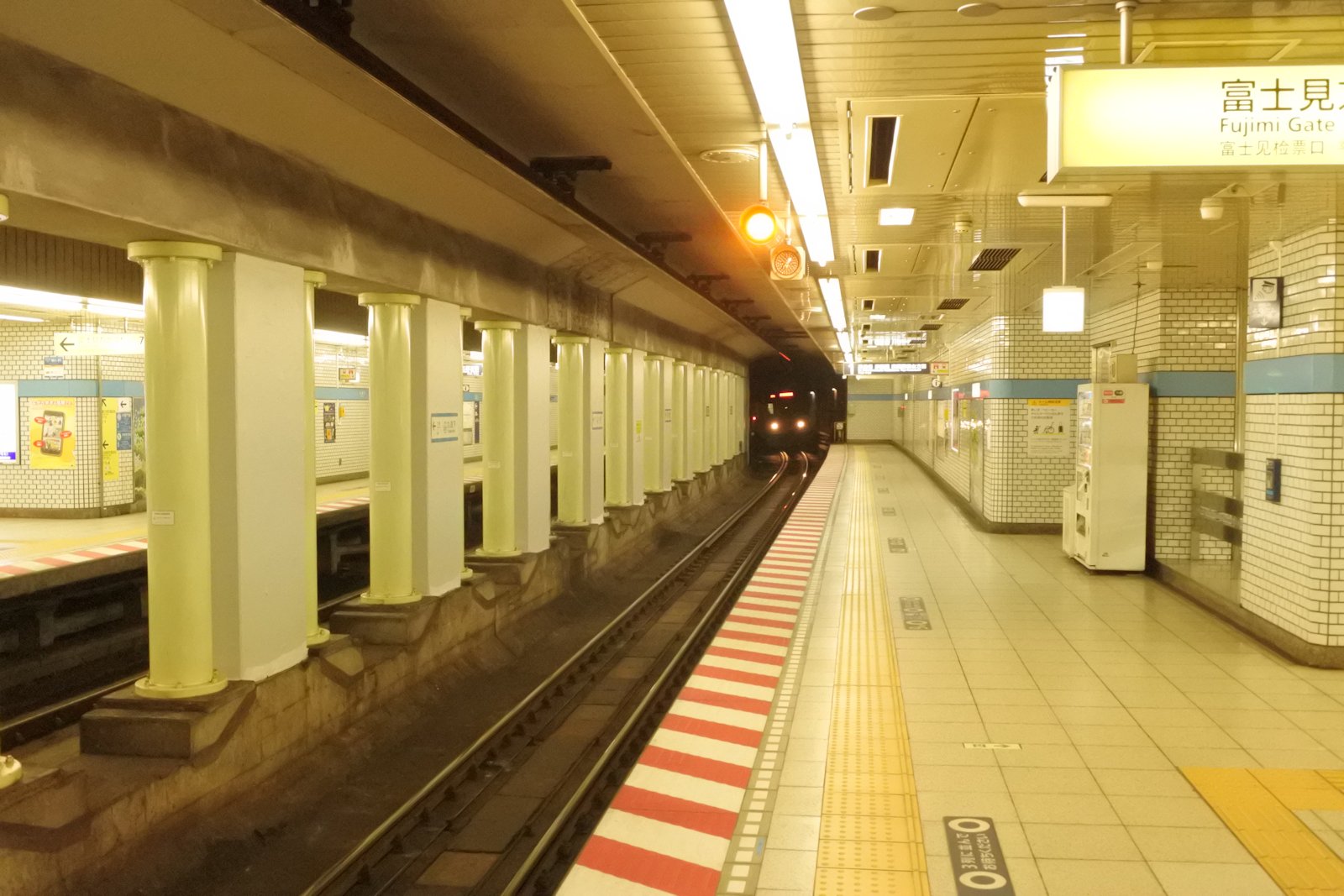
「アイカツスターズ!」風E231系800番台
「アイカツスターズ!」の第1話の最初のシーンを思わせる構図で、東京メトロ東西線九段下駅に入線するJR東日本E231系800番台を1枚撮影。「アイカツスターズ!」の第1話は主人公の虹野ゆめちゃんが憧れのアイドル、S4のライブを見に行くシーンから始まる。そのライブ会場が日本武道館であり、ゆめちゃんが九段下駅で列車を降りる描写が最初にある。九段下駅には東京メトロ東西線・半蔵門線、都営地下鉄新宿線の3路線が乗り入れているが、A線とB線(東京メトロ・都営地下鉄の路線では東京都心部が中間点となる路線が多いため上り・下りとは言わず、その代わりにこの言い回しを使う)の間の柱の形と駅の手前が右カーヴを描いていることから東西線のホームであることが判り、ゆめちゃんが乗っていた列車に使われていた車両も前面のデザイン、特に貫通扉と前照灯の位置からJR東日本E231系800番台の特徴を捕えて描かれていた。東京メトロ東西線で運行される車両としては最も稼働本数が少ない車両であるJR東日本E231系800番台であるが、どのダイヤに入るかがはっきりと判っているため、比較的容易に撮れる。原則としてE231系800番台で運行されるダイヤは、列車番号の末尾が「K」(「K」は東西線の場合JR東日本の車両で運行される列車を表す 東京メトロの車両で運行される列車は「S」 東葉高速鉄道の車両で運行される列車は「T」)である07K運用、03K運用、11K運用の3本だけで、このうち日中運用があるものは03K運用と11K運用の2運用である。At Kudanshita Station on Tokyo Metro Tozai Line, I photographed JR East E231-800 Series ready to drop into in the image of the very first scene of "AIKATSU STARS!" anime episode 1 when the heroine, Yume Nijino, went watching the musical performance of her longing singer at Nippon Budokan.To Kudanshita Station, three underground lines, Tokyo Metro Tozai Line, Tokyo Metro Hanzomon Line, and Toei Shinjuku Line come, but I recognised that the platform pictured in the anime was that on Tozai Line because of the shape of pillar between the two tracks and the right-hand curve near the platform end toward Nakano, and that the car which Yume rode was E231-800 Series because of the place of headlights and front emergence exit.Among the cars in service on Tozai Line, E231-800 Series is minor, but Japanese railfans find the timetable of the trains by E231-800 easily. Those are ones that the last of their operation code is "K", 07K, 03K, and 11K.
Jan 29, 2017
コメント(0)
-
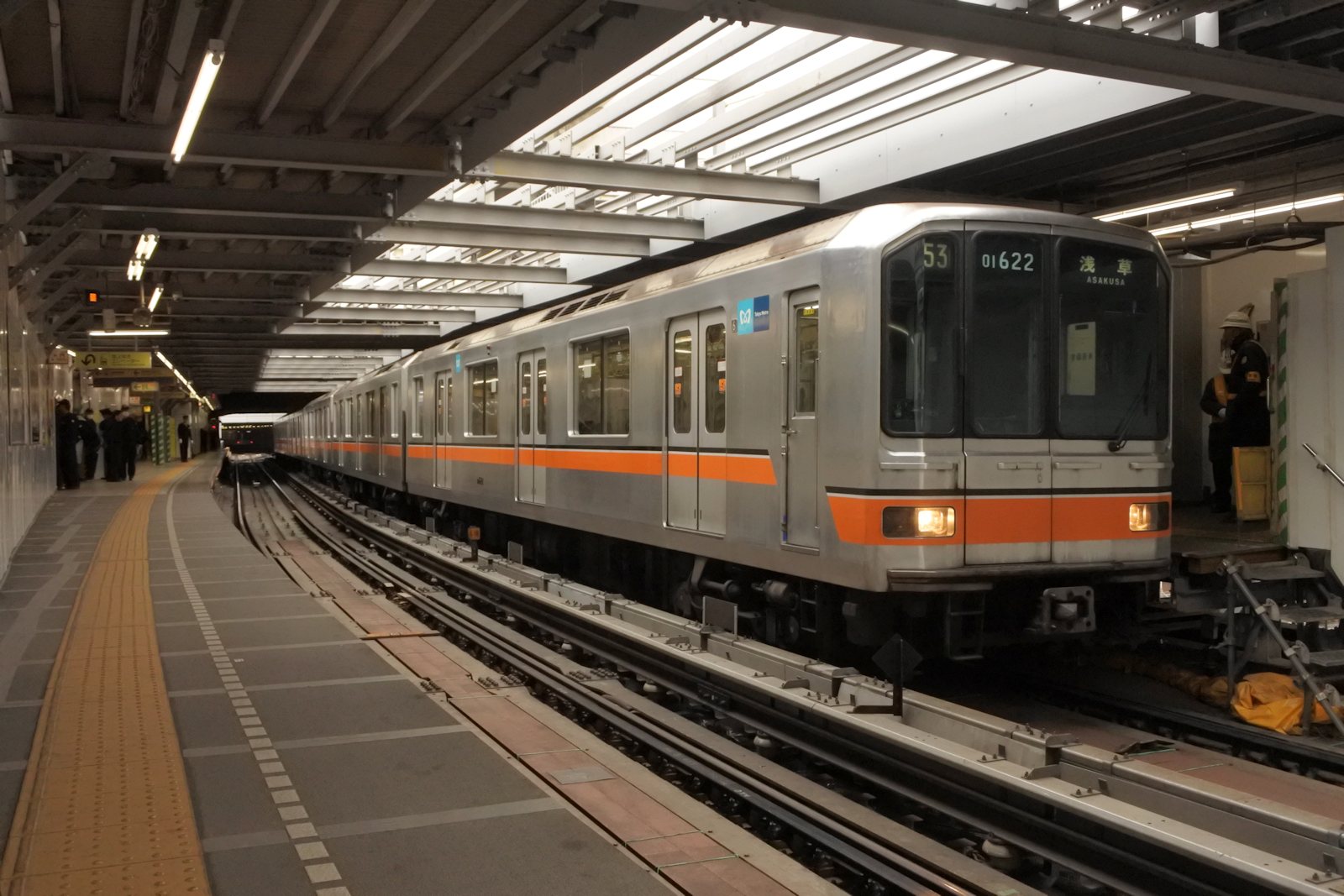
ラストラン直前 東京メトロ01系を撮る
東京メトロ1000系1139Fに乗ったのと同じ1月29日、1000系に置き換えられる形で数を減らしている01系も撮影した。01系は1983(昭和58)年から1997(平成9)年にかけて228両(6両編成38本)が製造された。01系は車体の規格が小さい銀座線に合わせて、機器の小型化・軽量化に力を入れたことが特徴。これまで千代田線用の6000系等で採用されてきた電機子チョッパ制御を、車体の長さが6000系等よりも4m短い16m級で、幅もこれらより0.25m狭い2.55mの小さな銀座線用の車両にも搭載できるように改良した、モーターの電機子(回転子)と界磁(固定子)を別々の制御装置で制御する高周波分巻チョッパ制御を採用した。発進加速時には、6000系等これまでの帝都高速度交通営団(営団地下鉄)の電機子チョッパ制御の車両とは異なる、音階で表すと、♪「ラレラー」という特徴的な音を発する。この他、ドアの開閉を音で知らせるドアチャイムやドア上鴨居に路線図式の案内表示器等、内装の接客設備も当時の最新のものを採用した。01-137Fと01-138Fは高周波分巻チョッパ制御からVVVF制御に変更して製造された。1000系の登場により引退・廃車が進み、2017(平成29)年1月現在、01-122Fと01-130Fの2編成が在籍している。このうち01-130Fは、1月1日から2月24日まで熊本県のマスコットキャラクター、くまモンがラッピングされて運行されている。熊本電気鉄道へ譲渡された車両(01-136F)にもくまモンがラッピングされており、その弟分として期間限定で銀座線でも運行されている。ラッピングのデザインは熊本電気鉄道の車両とほぼ共通のものとなっている。これら現役で残る2編成も、1000系の増備が終了することに伴い、2017(平成29)年3月10日での引退が決定している。引退した編成のうち、01-101Fは3両編成に短縮されたうえで中野車両基地で保存、01-135Fと01-136Fは熊本電気鉄道へ譲渡され、上熊本線で活躍している。上熊本線は銀座線とは集電方式と線路幅の規格が異なり、銀座線の第三軌条(サードレール)集電方式、1435mm軌間(標準軌)に対して、上熊本線は架空電車線(架線)集電方式、1067mm軌間(狭軌)であることから、シングルアームパンタグラフの設置と台車の交換が実施された。同時に高周波分巻チョッパ制御からVVVF制御へも改造された。On January 29th, the very same day as when I travelled with and photographed Tokyo Metro 1000 Series 1139F, I also photographed 01 Series, whose retirement on March 10th, 2017, had been announced.01 Series had been built 228 cars (thirty-eight 6-car sets) between 1983 and 1997.To match a small space, the underfloor equipment were designed to be emphasised on downsizing because the size of cars on Ginza Line is more 0.25-metre/0.82-foot narrow and 4-metre/13.12-foot shorter than 2.8-metre/9.19-foot wide and 20-metre/65.62-foot long 6000 Series on Chiyoda Line. 01 Series introduces the newly-developed pulse width modulation control system that voltage of field supply and armature supply circuits controlled by separated chopper. In addition, door chime and route map showing train's bound and where train runs above the doors. Different from pre-existing cars such as 6000 Series, this new-type chopper sounds like "A D A " in C major scale.The two last-made sets, 01-137F set and 01-138F set, were redesigned to adjustable voltage and frequency (AVAF) controlled car.in January, 2017, two sets, 01-122F and 01-130F, which have a livery of Kumamon, the mascot of Kumamoto Prefecture, like the ones moving to and in service on Kumamoto Electric Railway Kami-kumamoto Line between January 1st and February 24th, are existing.Among the ones already retired from regular operations, 01-101F set shortened to 3-car set and is preserved at Nakano Railyard and 01-635F set and 01-636F set moved to Kumamoto Electric Railway Kami-kumamoto Line, shortened to 2-car set, installed pantographs, and changed bogies to match 1.067-metre/42.01-inch gauge.01-122F01-130F
Jan 29, 2017
コメント(0)
-

新しいのに懐かしい 東京メトロ1000系1139Fに乗る
29日、去る1月17日より営業運転を開始した東京メトロ1000系の特別仕様車、1139Fに乗った。東京メトロ1000系は2012(平成24)年にデビューした銀座線用の車両。2組ある車軸のうち1軸にだけモーターを取り付け、モーターのない車軸の角度がカーヴの半径(R)に合わせて曲がりやすいように変わる操舵機構を採用した台車、消費電力が少ない永久磁石同期(PMS)モーター、LED車内照明・前照灯等の最新技術を導入した反面、銀座線の初代車両で、1927(昭和2)年の上野駅~浅草駅間開業時から1968(昭和43)年まで活躍した東京地下鉄道1000形に似せた黄色と茶色に銀座線のラインカラーである山吹色・白色・紺色のラインが入ったラッピングを纏った新しさと懐かしさが入り交じった車両である。これらの要素が評価され、2013(平成25)年に帝都高速度交通営団(営団地下鉄)・東京メトロの車両として初めてブルーリボン賞を受賞した。1000系の最終増備車である1139Fと1140Fの2本は、性能面ではそれまでの車両(1101F~1138F)と同様であるが、外観・内装をより東京地下鉄道1000形のそれを模した特別仕様車である。既存の編成との違いは、外観では、側面のラインを廃止し、前面の前照灯がそれまでの2灯から東京地下鉄道1000形と同じ1灯に変わった点が大きな特徴。内装では、木目調の化粧板を基調に緑色のモケットの座席、真鍮色の手すり、リコ式つり革(普段は荷棚に寄っており、乗客が手前へ引っ張って握る金属製のつり革)を模した雨粒形の持ち手のつり革、予備灯(1139F・1140Fではイベント列車として運行される時に使用。東京地下鉄道1000形ではポイント通過時等台車の集電装置(コンタクトシュー)が線路脇に設置された電気の流れているサードレールに当たっていない時に消灯する車内照明に代わって点灯した。東京メトロ1000系は集電装置がサードレールに当たっていない時には予備電源を使用するため普段は使用しない。)、東京地下鉄道1000形製造当時(1927(昭和2)年)のものを再現したメーカーと製造年次を示すプレート等、東京地下鉄道1000形の雰囲気を蘇らせている。僕は銀座線の数少ない撮影ポイントの1つ、渋谷駅の降車ホームでカメラを構え、1139Fが来るのを待った。撮影後、一度改札口を抜けて反対側の乗車ホームへと回り、上野検車区渋谷分室から折り返してきた1139Fの浅草行き列車に乗る。木目調の化粧板の車内は独特の温もりを醸し出している。Tokyo Metro ビジョンと両開きのドアから平成の東京メトロ1000系だと判別できるが、1139Fに乗った瞬間、昭和初期にタイムスリップしたかのような気持ちになれた。僕は終点・浅草駅まで乗車し、そのまま再び渋谷駅まで折り返した。2017(平成29)年12月30日、銀座線は上野駅~浅草駅間の開業から90周年を迎える。僕としては、同日に1139Fもしくは1140Fを使用した記念の臨時列車を運行してほしいところである。On 29th, I travelled with and photographed Tokyo Metro 1000 Series 1139F set, which is a special design car resembling to old 1000 Series, the first generation one on Ginza Line.Tokyo Metro 1000 Series debuted in 2012, introducing new technologies, such as bogies consisting of a motored fixed axle and a non-motored steerable axle, permanent magnetic synchronous motor, LED headlights and interior lights. On the other hand, its body colour was based on that of old 1000 Series, yellow and brown, on which three-coloured (orange, white, and navy blue) line is drawn.Evaluated in terms of these elements, 1000 Series won Blue Ribbon Prize in 2013, which was first time among cars of Teito Rapid Transit Authority and Tokyo Metro.The last-made two sets, 1139F and 1140F, are designed as the special car to recreate the atmosphere of old 1000 Series more than the existing ones.Of its exterior, the number of headlight becomes one from two and the line on the side is eliminated. Of its interior, woodtone wall panel, green-coloured seatings, brass-coloured grab handle, raindrop-shaped hanging strap designed in the image of old pivoted grab handles, and auxiliary lamps, which is for event use to copy the ones that old 1000 Series equipped lighted up when its interior got black out because its contact shoes of its bogies untouched third rail for electric supply, such as when the train switched.I waited for 1139F set coming at Shibuya Station, which is known as a rare photo spot on Ginza Line.Soon after photographing, I moved to opposite platform because the one where I photographed was arrival only.As I got on, I felt the characteristic atmosphere of its interior as if I was in 1920s or 1930s, the first ten years of Showa Period in Japan.I travelled one round trip on all line, between Shibuya Station and Asakusa Station.In 2017, Ginza Line marks its 90th anniversary since open of its first section between Ueno Station and Asakusa Station. I wish a special train to celebrate the 90th anniversary by 1139F or 1140F set between the first-opening section would operate on December 30th, its opening day.渋谷駅に停車中の1139F 1139F set stopping at Shibuya Station1139Fの内装 Interior of 1139F set製造年次・製造メーカーを示すプレート A plate showing built year and factory1139Fの座席 Seating of 1139F set1139Fの荷棚とつり革 luggage rack and hanging strap of 1139F東京地下鉄道1000形のリコ式つり革をイメージした1139Fのつり革 hanging strap of 1139F designed in the image of pivoted grab handles渋谷駅へ入線する1139Fを渋谷ヒカリエから臨む 1139F set arriving at Shibuya Station from Shibuya Hikarie
Jan 29, 2017
コメント(0)
-
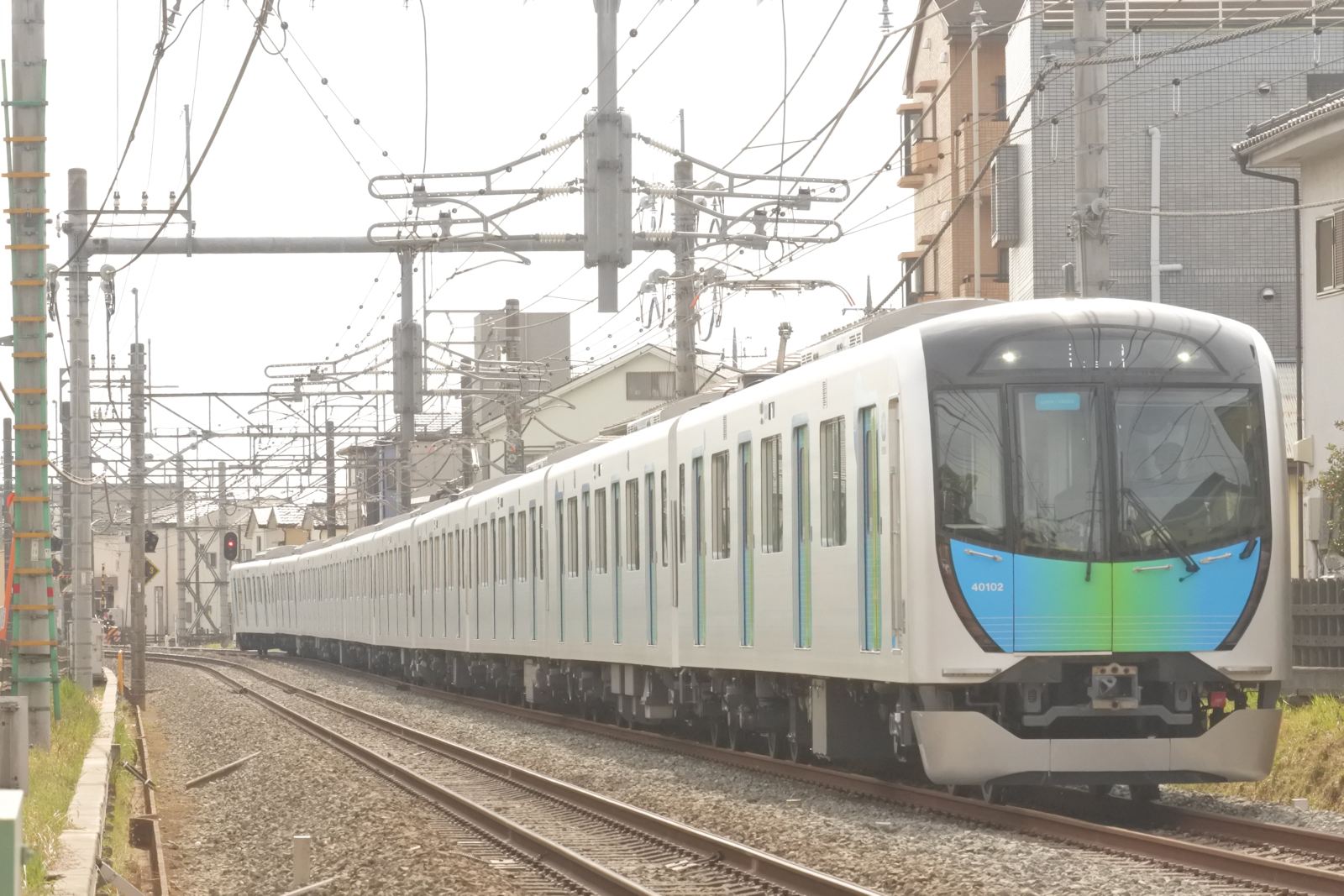
3月25日デビューの西武40000系「S-TRAIN」に対して思うこと
2017(平成29)年期待の新星の1車種、西武40000系が「S-TRAIN」の列車愛称で3月25日にデビューすることが1月10日に西武鉄道と運行各社(東京メトロ・東急電鉄・横浜高速鉄道)から発表された。同時にダイヤと指定席料金も発表され、土休日は元町・中華街駅~所沢駅・飯能駅・西武秩父駅間(西武秩父駅発着・飯能駅発着各1往復、所沢行き北行き1本)、平日は豊洲駅~所沢駅間で運行される。停車駅は、土休日の元町・中華街駅発着列車が、元町・中華街 - みなとみらい - 横浜 - 自由が丘 - 渋谷 - 新宿三丁目 - 副都心線池袋 - 石神井公園- 所沢 - 入間市 - 飯能 - 西武秩父平日の豊洲駅発着列車が、豊洲 - 有楽町 - 飯田橋 - 石神井公園 - 保谷 - 所沢となる。なお、土休日ダイヤでは、横浜駅とみなとみらい駅は南行き(元町・中華街方面行き)の場合は降車専用駅、北行き(所沢・飯能・西武秩父方面行き)の場合は乗車専用駅、副都心線池袋駅は南行き・北行き共に降車専用駅となる。また副都心線内のみの乗車もできない。平日ダイヤでは、東行き(豊洲方面行き)の場合、保谷駅と石神井公園駅が乗車専用駅、飯田橋駅と有楽町駅が降車専用駅となり、西行き(所沢方面行き)の場合はその逆で、有楽町駅と飯田橋駅が乗車専用駅、石神井公園駅と保谷駅が降車専用駅となる。土休日ダイヤでは元町・中華街駅~西武秩父駅間を北行きは2時間14分、南行きは2時間33分で、平日ダイヤでは豊洲駅~所沢駅間を最速58分で結ぶ。指定料金は、主要駅間を見ると、土休日ダイヤの元町・中華街駅および横浜駅から渋谷駅までが350円、副都心線池袋駅までが560円、飯能駅までが860円、西武秩父駅までが1060円、平日ダイヤは東京メトロ有楽町線各駅~池袋線各駅間いずれも510円となる。西武鉄道・東京メトロ・東京急行電鉄・横浜高速鉄道が西武鉄道の新型車両40000系を使用した座席指定列車を西武池袋線~東京メトロ有楽町線、および西武西武秩父線・池袋線~東京メトロ副都心線~東急東横線~横浜高速鉄道みなとみらい線での運行を開始すると発表したは、2016(平成28)6月16日のことだった。西武鉄道では初めてのロング・クロス両用のデュアルシートを備える車両である40000系を投入し、通勤型車両でありながらクロスシート時の特性を活かした座席指定列車としたこと、そしてそれまで追加料金が必要な座席指定もしくは整理券制の列車がなかった東急電鉄と横浜高速鉄道では、他社の車両で運行されるものの初めての座席指定列車が運行されることから、鉄道ファンから大きな注目を集めていた。これより、僕の考察を書き表す。停車駅については、僕はこの発表がある以前から、「S-TRAIN」の停車駅を予想していた。以下に僕の予想を示す。土休日ダイヤ元町・中華街 - 横浜 - (武蔵小杉) - 渋谷 - 新宿三丁目 - 副都心線池袋 - 練馬 - 所沢 - 入間市 - 飯能 - 西武秩父平日ダイヤ新木場 - 豊洲 - 有楽町 - 永田町 - 飯田橋 - 有楽町線池袋 - 練馬 - 所沢 - 入間市 - 飯能最初に土休日ダイヤの副都心線・東横線・みなとみらい線方面の列車については、みなとみらい線・東横線内は横浜高速鉄道と東急電鉄にとっては座席指定列車の運行は初めてであることから、現行の東横線・みなとみらい線の最速列車、東横特急(Fライナー)よりも停車駅が少ないものになると予想していた。僕の予想は、2001(平成13)年に東横特急が運行を開始した当初と同様に、それまで急行が停まっていた、なおかつ東急電鉄にとっては歴史上重要な駅であった田園調布駅や日吉駅を思い切って通過させた前例があることから、今回も思い切って減らした、横浜駅~渋谷駅間ノンストップ、もしくは路線全体のほぼ中間に武蔵小杉駅のみ停車というパターンだったが、結果は途中駅は自由が丘駅のみ停車というものとなった。副都心線内も、急行列車が停車する明治神宮前駅(2008(平成20)年の開業当初は急行列車も明治神宮前駅を通過していた)と、東京メトロと西武鉄道の境界駅である小竹向原駅が通過駅となる点は予想通りだった。池袋線・西武秩父線内の停車駅は、ほぼ特急レッドアロー号のものに準じたものとなることを予想していたが、以前にも書いたとおり、飯能駅~西武秩父駅間の駅で10両分の長さのホームを持つものは飯能駅・東飯能駅・西武秩父駅の3駅だけであることから、池袋駅発の特急レッドアロー号が停車する横瀬駅には10両編成の40000系は停車しないと見ていた点は予想通りであった。反面、西武有楽町線と池袋線で保安装置の違いがあるため、両線の接続駅である練馬駅には停車すると見ていたが、通過駅となり、石神井公園駅に停車するパターンとなった。続いて平日ダイヤの東京メトロ有楽町線方面の列車については、豊洲駅~所沢駅間の運行であるということが予想から大きくずれた。日中に運行される東京メトロ有楽町線直通列車が新木場駅~小手指駅間での運行であるため、それよりも長距離での利用を意識した列車になると予想し、新木場駅~飯能駅での運行を予想していた。東京メトロ有楽町線内の停車駅は、かつて不定期に運行されていた、小田急小田原線・東京メトロ千代田線から東京メトロ有楽町線へ直通していた特急「ベイリゾート」の停車駅も参考にしながら予想したが、駅周辺にオフィス街が広がる飯田橋駅と有楽町駅に停車することは正解だったが、官庁街に近い永田町駅は通過となった。そして、利用客が多い有楽町線池袋駅が通過駅となったという点は、池袋駅の混雑を解消するための施策であると見て取れる。続いて所要時間の点では、元町・中華街駅および横浜駅から池袋駅では、東横特急・副都心線急行(Fライナー)と比べて停車駅が4駅も少ない(「S-TRAIN」は東横特急の停車駅のうち菊名駅、武蔵小杉駅、中目黒駅を、副都心線急行列車の停車駅のうち明治神宮前駅を通過する)にもかかわらず、1分の短縮にしかなっていないうえに、所沢駅もしくは飯能駅まででは、「S-TRAIN」のほうが1分長くなってしまう。「S-TRAIN」が朝と夕方・夜間のみの運行であり、時間帯の違いを考慮しても、停車駅が少ないことを活かせていないと言いたい。3点目は、みなとみらい線内における誤乗対策である。「S-TRAIN」の休日ダイヤの停車駅が東横特急(Fライナー)と同じとなったにも関わらず、みなとみらい線内のみの乗車が南行き・北行き共にできない点に。「S-TRAIN」のみなとみらい線内の停車駅が横浜駅・みなとみらい駅・元町・中華街駅と東横特急(Fライナー)と同じであることから、南行き列車のみを対象に、みなとみらい線内のみを座席指定料金なしで「S-TRAIN」の空席に座れるようにしてはいかがだろうか(当然満席の場合は乗車不可)。南行き列車の場合、自由が丘駅以北からの乗車の場合は横浜駅より先は降車専用でも構わないが、「S-TRAIN」に完全にみなとみらい線内のみの乗車ができなくしてしまうと、指定券のない誤乗が少なからず発生してしまうだろうとみられる。そのため、みなとみらい線内は横浜駅以北からの乗客が減少する一方であることから、東横特急(Fライナー)と停車駅の面で差別化できなかった代償という訳ではないが、みなとみらい線内のみを指定券なしで「S-TRAIN」に乗車できるようにすると、より利便性が向上するのではないだろうか。なお北行き列車はみなとみらい線・東横線から副都心線・池袋線・西武秩父線方面への速達列車という性格が強いことから、前述の特例は設けない。最後に、1つ残る疑問点として、元町・中華街駅発着、豊洲駅発着のどちらも東京メトロと西武鉄道の境界駅である小竹向原駅と、保安装置が違う西武有楽町線と池袋線の接続駅である練馬駅が停車駅とならなかった点である。ということは、土休日ダイヤの副都心線池袋駅~石神井公園駅間、ならびに平日ダイヤの飯田橋駅~石神井公園駅間では、小竹向原駅と練馬駅で2回の運転停車(乗客の乗り降りができない停車)が発生してしまうかもしれないということである。小竹向原駅は東京メトロと西武鉄道の事業者境界駅であるため、同駅で乗務員交代(副都心線からの列車の場合は自動運転から手動運転への切り替えも実施)のための運転停車が実施されるものとみられるが、練馬駅では、西武有楽町線と池袋線で保安装置の違いがあるため、保安装置の切り替えが必要となる。もしも40000系が保安装置の自動切り替えができない場合には、小竹向原駅で乗務員交代と運転モードの切り替え(土休日ダイヤの場合)、練馬駅で保安装置切り替えのための運転停車が立て続けに発生してしまう。そしてこれらの運転停車が、所要時間短縮の大きな壁となっていることだろう。所要時間の短縮には、土休日ダイヤにおける東京メトロ副都心線のうち、池袋駅~小竹向原駅間はATO運転ではなく手動運転とし、車両に保安装置自動切り替え機能を取り付け、小竹向原駅と練馬駅では通過時に保安装置を自動で切り替えられるようにするなどの工夫が必要であると言いたい。確実に着席できるという点では「S-TRAIN」は魅力的な列車と言えるが、現段階では所要時間の短縮が課題と言えよう。東横線・副都心線の最大の課題とも言うべき、JR東日本湘南新宿ラインとの競争で優位に立つには、横浜駅~渋谷駅および池袋駅の所要時間を、今回発表されたダイヤよりもさらに2分程度短縮させる必要があると言いたい。着席保証と所要時間の短縮の2点で「S-TRAIN」の導入効果を得られるのは、現段階ではそれまで直通する全列車が練馬駅~豊洲駅間各駅停車だった東京メトロ有楽町線内にも通過駅がある平日ダイヤと、休日ダイヤではそれまで直通する列車が運行されていなかった元町・中華街駅、みなとみらい駅、横浜駅から西武秩父駅まで乗車した場合に限られるであろう。僕個人の気持ちとしても、停車駅が東横特急(Fライナー)よりも少ないことに過剰な期待を寄せてしまったことを反省している。運行開始時点では、40000系が2編成しか在籍していないため、運行本数が少ない状況となるが、今後40000系が増備され次第、「S-TRAIN」の運行本数も増発され、より利便性の高い列車となることを期待したい。On January 10th, Seibu Railway and relative railway companies, Tokyo Metro, Tokyu Corporation, and Yokohama Minatomirai Railway, announced that a new reserved-seating train named "S-TRAIN", operated by Seibu 40000 Series, would start to run on March 25, 2017, which would run between Seibu-chichibu Station on Seibu Seibu-chichibu Line and Motomachi-chukagai [Motomachi・Yokohama Chinatown] Station on Yokohama Minatomirai Railway Line on Saturdays and holidays, and does between Toyosu Station on Tokyo Metro Yurakucho Line and Tokorozawa Station on Seibu Ikebukuro Line.Reserved-seating charge and timetable were also announced. "S-TRAIN" stops at Motomachi-chukagai [Motomachi・Yokohama Chinatown], Minatomirai, Yokohama, Jiyugaoka, Shibuya, Shinjuku-sanchome, Ikebukuro (on Fukutoshin Line), Shakuji-koen [Shakujii Park], Tokorozawa, Irumashi, Hanno, and Seibu-chichibu Stations in Saturday and holiday service, and Toyosu, Yurakucho, Iidabashi, Shakuji-koen [Shakujii Park], Hoya, Tokorozawa Stations in weekday service.It takes 2 hours and 14 minutes (north bound)/2 hours 33 minutes (south bound) between Motomachi-chukagai [Motomachi・Yokohama Chinatown] and Seibu-chichibu, and it does 58 minutes as the fastest between Toyosu and Tokorozawa. Seating charge costs 350 yen to Shibuya, 560 yen to Ikebukuro, 860 yen to Hanno, and 1060 yen to Seibu-chichibu from Motomachi-chukagai [Motomachi・Yokohama Chinatown] or Yokohama, and 510 yen wholly within the weekday services.Riding only on Fukutoshin Line or Yokohama Minatomirai Railway Line on Saturdays and holidays isn't available.When the press release that a reserved-seating train by Seibu 40000 Series, which was first Seibu Railway car convertible seating between longitudinal and forward-facing, would debut was announced was June 16, 2016. Many railfans paid attention to it because not only reserved-seating commuter train, but it was first train that passengers required an additional charge on Tokyu Corporation and Yokohama Minatomirai Railway.From here, I would like to write my opinion.At first, I would like to treat the stations. Before the stations at which "S-TRAIN" stops were officially announced, I expected which stations "S-TRAIN" stopped. My expectation was as follows.On Saturdays and holidays, Motomachi-chukagai [Motomachi・Yokohama Chinatown], Yokohama, Musashi-kosugi (not all trains), Shibuya, Shinjuku-sanchome, Ikebukuro (on Fukutoshin Line), Nerima, Tokorozawa, Irumashi, Hanno, Seibu-chichibu, and on weekdays, Shin-kiba, Toyosu, Yurakucho, Nagatacho, Iidabashi, Ikebukuro (on Yurakucho Line), Nerima, Tokorozawa, Irumashi, Hanno.On Tokyu Toyoko Line and Yokohama Minatomirai Railway Line, the stations could be less than those of limited express (F-Liner), the fastest train stopping at Motomachi-chukagai [Motomachi・Yokohama Chinatown], Minatomirai, Yokohama, Kikuna, Musashi-kosugi, Jiyugaoka, Nakameguro and Shibuya, which almost comes true. My expectation was no middle station or only one middle station, such as Musashi-kosugi, would stop because limited express train passes Den-en-chofu Station and Hiyoshi Station, both of which are regarded as the most important stations in the history and express train stops. Comparing the result to my expectation, stopping only one middle station is the same, but it is Jiyugaoka.On Fukutoshin Line, it is the completely same as my expectation. Just like Toyoko Line and Yokohama Minatomirai Railway Line, the stations at which "S-TRAIN" stops is less than those of express (F-Liner), which stops at Shibuya, Meiji-jingu-mae [Meiji Jingu Shrine], Shinjuku-sanchome, Ikebukuro, and Kotake-mukaihara; it stops at Shibuya, Shinjuku-sanchome, and Ikebukuro only.On Seibu Yurakucho Line and Ikebukuro Line I expect "S-TRAIN" would stop at the almost same stations as those of limited express "Red Arrow" from Ikebukuro on Ikebukuro Line, but, as I wrote before, 10-car "S-TRAIN" wouldn't stop at Yokoze Station because of the length of platform, which also comes true. On the other hand, Nerima Station doesn't stop (or stops but no passengers can't get on or off). It fell short of my expectation that "S-TRAIN" on weekday would operate between Shin-kiba and Hanno actually to operate between Toyosu and Tokorozawa.I expected that "S-TRAIN" on weekday would operate longer than local train on daytime (between Shin-kiba and Kotesashi) to target passengers going farther than Kotesashi.My expectation which station "S-TRAIN" would stop on Tokyo Metro Yurakucho Line was based on those of "Bay Resort" limited express, which used to operate on Odakyu Odawara Line, Tokyo Metro Chiyoda Line, and Tokyo Metro Yurakucho Line.Comparing to my expectation, Nagatacho Station and Ikebukuro Station aren't chosen.I see why "S-TRAIN" doesn't stop at Ikebukuro Station on Tokyo Metro Yurakucho Line may be to decrease the crowdedness.The second is travel time. Though "S-TRAIN" stops at less stations than limited express ("F-Liner"), it could shorten its travel time only one minute than limited express between Motomachi-chukagai [Motomachi・Yokohama Chinatown] or Yokohama and Ikebukuro and takes more one minute between Motomachi-chukagai [Motomachi・Yokohama Chinatown] or Yokohama and Tokorozawa or Hanno. I would like to say that "S-TRAIN" couldn't fully use its merit.The third is the solution for wrong ride on Yokohama Minatomirai Railway Line.Though it stops at the same stations as limited express (F-Liner) on Yokohama Minatomirai Railway Line, no passengers can ride on south bound "S-TRAIN" only on Yokohama Minatomirai Railway Line, which can make some people confused and cause wrong ride.It may be better to create new rule that passengers could ride on south bound "S-TRAIN" without seat reservation from Yokohama Station or Minatomirai Station because passengers travelling from farther than Jiyugaoka Station gradually decrease from Yokohama Station. The more passengers get off, the more unoccupied seatings there are in the train.At last, I have a question; I wonder how to switch the safety devices or drive mode at Kotake-mukaihara Station, the border of Tokyo Metro Yurakucho Line or Fukutoshin Line and Seibu Yurakucho Line, and Nerima Station, the border of Seibu Yurakucho Line and Ikebukuro Line, both of which "S-TRAIN" passes on timetable, which means that "S-TRAIN" stops twice on its way to Shakuji-koen [Shakujii Park] Station both on Saturdays and holidays and weekdays.At Kotake-mukaihara Station, the trains going through Seibu Yurakucho Line and Ikebukuro Line need to change driver and conductor because of the border between the two railway companies. In addition, in case of Fukutoshin Line trains, the driver changes its driving mode between automatic control to manual control. Though the timetable says that "S-TRAIN" passes Kotake-mukaihara, those both on Saturday and holiday and weekday also has to stop to change them.Not only that, because Seibu Yurakucho Line and Ikebukuro Line introduce different safety devices, though the two lines are operated by the same company, "S-TRAIN" also has to stop at Nerima Station to switch between the two devices if the car doesn't install automatically-switcher for the safety devices."Pass" at Kotake-mukaihara and Nerima can mean that "no passengers can get on and off, in other words, stop only for change of driver and conductor, or switch between different safety devices."It is needed to resolve the stops, such as making a transition from automatic control to manual control between Ikebukuro and Kotake-mukaihara on Fukutoshin Line and equipment of the automatically-switcher with the car."S-TRAIN" looks attractive from the point of view of a train ensuring the seating, but speed-up can be an issue. Especially, to be faster than JR East Shonan-shinjuku Line train between Yokohama and Shibuya or Ikebukuro, more two minute shortening is needed.The travels reaping a benefit "S-TRAIN" may be weekday operation, on which all trains stop at all stations between Nerima and Toyosu, and between Yokohama Minatomirai Railway and Seibu-chichibu Line only.I have to reflect on my overexpectation that the stations where "S-TRAIN" stops are less than limited express (F-Liner) leads the shortening the travelling time.Seibu 40000 Series exists only two sets and "S-TRAIN" operates five times on Saturdays and holidays and seven times on weekdays a day from this coming March 25, but I look forward to being more "S-TRAIN" operates as more Seibu 40000 Series are built.西武鉄道プレスリリース「2017年3月25日(土)から「S-TRAIN」運行開始!」 2017年1月10日
Jan 28, 2017
コメント(0)
-
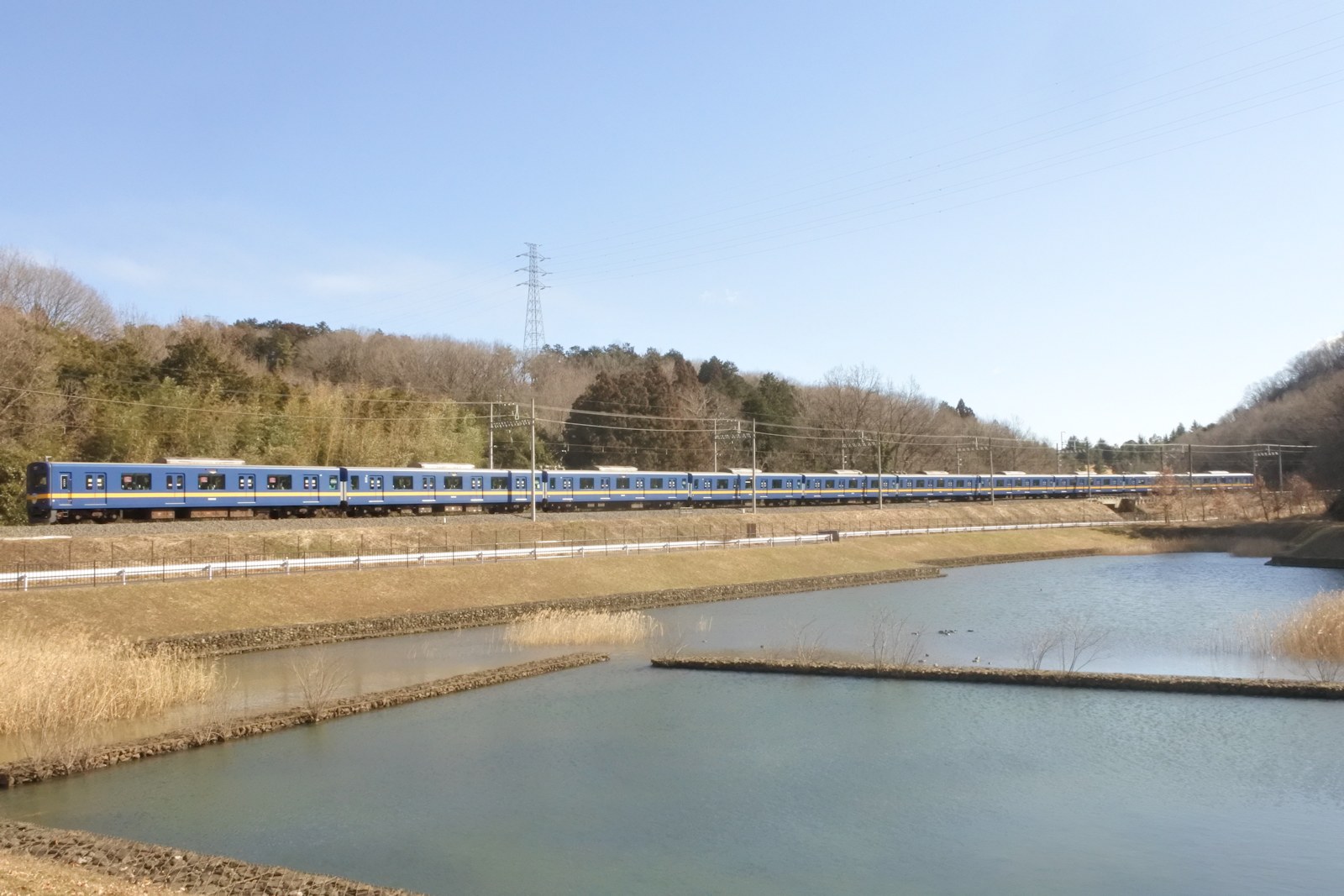
50090系51092Fの「ブルーバード」を撮る
21日、東武50090系51092Fによる池袋駅~寄居駅間の臨時列車を撮影した。今回の臨時列車は、鉄道好きアイドルの豊岡真澄さんと、豊岡さんのホリプロ所属時代のマネージャーでありながら鉄道好きタレントとしても活動する南田裕介さんをゲストに迎え、下板橋駅の留置線・高坂駅の側線・森林公園検修区といった普段営業運転では列車が走らない線路を経由して、寄居駅まで運行されたものである。51092Fは2015(平成27)年11月に東上線全線開業90周年を記念して、かつて同線で活躍した5310系「フライング東上」の塗装を再現した、青地に黄色帯のラッピングを車体に纏っている。当初は2016(平成28)年11月頃までの運行を予定していたが、2017(平成29)年1月現在もラッピングを纏い続けている。かつての「フライング東上」とは、春と秋の行楽シーズンに池袋駅~寄居駅間で運行された運行された特急列車のことである。1949(昭和24)年の運行開始当初は料金不要の急行列車として登場し、1952(昭和27)年に伊勢崎線(現在の東武スカイツリーライン区間)・日光線の特急列車として活躍した5310系が「フライング東上」用の車両として東上線へ転属し、同時に特急料金が必要な特急列車に格上げされた。「フライング東上」用の5310系は、濃紺色に黄色帯の塗装を纏い、4両編成を組んだ。このうち1両は車内スピーカーで音楽を流す「ミュージックカー」という車両だった。「ミュージックカー」は急行列車時代から連結されていた車両で、5310系の転属と同時に「ミュージックカー」の設備が同車に移設された。5310系による「フライング東上」は池袋駅~寄居駅間の運行だったが、急行列車時代は秩父鉄道秩父本線へ直通し、長瀞駅まで運行された。「フライング東上」の特急格上げ後、秩父本線への直通運転は土休日の行楽急行列車へと譲った(その秩父本線直通の行楽急行列車は、のちに料金不要の特急列車となり、「ながとろ」「みつみね」等の愛称を付けて1992(平成4)年まで運行された)。秩父本線へ直通しなくなったことから、5310系による「フライング東上」は利用者数が思わしくなく、1956(昭和31)年に料金不要の列車に格下げされたものの、車両は5310系のまま、1962(昭和37)年に伊勢崎線系統の急行列車(現在の特急「りょうもう」の前身)の増発に伴い、同線へ転属するまでの間運行された。この「フライング東上」用の5310系は団体臨時列車としても運行された。団体臨時列車として運行される時は「ブルーバード」を名乗り、沿線の学校の遠足等に利用された。今回は、「フライング東上」カラーのラッピングを纏った51092Fを使用した臨時列車ということから、5310系時代の「ブルーバード」と同様に、前面には「BLUE BIRD 青い鳥号」のヘッドマークを付けて運行された。寄居・長瀞方面への行楽列車として活躍した5310系の雰囲気を出すために、森林公園駅以北の山あいの区間を走る姿を撮ろうと臨んだ。今回の撮影場所は、東武竹沢駅~男衾駅間。沿線の緑と池と共に撮影した。池は本田技研工業(Honda)の工場の敷地内にある人工の小さな雨水調整池であるが、秩父山麓の自然と合わせると、あたかも観光地であるかのように見えてくる。51092Fは10両編成で、かつての5310系よりも長い編成であるが、10両全部を収めることができた。2005(平成17)年以降、小川町駅を境に運行系統が分断され、8000系ワンマン車の各停列車のみの運行となった小川町駅~寄居駅間に久しぶりに池袋駅からの列車が入線した。2008(平成20)年に廃止された特急に替わって新設された「TJライナー」は、夕方・夜間に(2016(平成28)年3月からは朝間時にも運行)運行される通勤客向けの着席整理券制列車で、行楽客向けだった「フライング東上」とは性格が異なる。また「TJライナー」用の50090系は、5310系とは違い、ロング・クロス両用デュアルシートで、「TJライナー」以外の料金不要の列車の運行にも就く。しかし両列車は、東上線を走る有料列車という点で共通しており、50090系が5310系の後、長いブランクを経て復活した東上線の有料列車にも使われる車両として、5310系のカラーリングを復活させるに一番ふさわしい車両だったと言えよう。実現可能な提案としては、土休日に運行される快速急行列車を、クロスシート状態にした50090系による特急料金廃止後の「フライング東上」のような列車に変更してみてはいかがだろうか。On 21st, I photographed Tobu 50090 Series being in service as a special train between Ikebukuro Station and Yorii Station on Tobu Tojo Line, featuring Masumi Toyooka, who is known as a railfan and used to be the pioneer of the railfan girls, and Yusuke Minamida from Horipro Inc., who managed Toyooka when she belonged to Horipro and known as a railfan and sometimes appeared on TV programmes.51092F set has a livery the same as 5310 Series, which used to run on Tojo Line as "Flying Tojo" limited express service in 1950s and 1960s, navy blue with yellow line since November, 2015."Flying Tojo" limited express had been in service between 1949 and 1962. At first, it ran as a express train without seating reservation on holidays in spring and autumn. In 1952, four cars of 5310 Series, a car used to be in service as limited express trains on Tobu Isesaki Line (section commonly called "Tobu SKYTREE Line" in the present) and Nikko Line between Asakusa and Tobu-nikko, moved to Tojo Line and started to operate as "Flying Tojo". At the same time, "Flying Tojo" upgraded to limited express seating reservation was required.5310 Series for "Flying Tojo" was consisted of four cars including the one called "music car", installing music audio instruments, which was moved from an old car when it operated as express."Flying Tojo" operated by 5310 Series ran Ikebukuro Station and Yorii Station, but in express train period it went through Chichibu Railway Chichibu Main Line to Nagatoro Station. Instead of "Flying Tojo", holiday express trains started to run as the going-through service to Chichibu Main Line (holiday express would change to limited express without seating reservation and continued until 1992). Because of the shortening its operating section, the number of passengers on "Flying Tojo" grew at a sluggish pace and stopped collecting additional fee in 1956. However, 5310 Series kept being in service until it moved to Isesaki Line for reserved-seat express train, become the predecessor of "Ryomo" limited express, in 1962.During 5310 Series was in service on Tojo Line, it also ran as special train for party of tourists or students.for school excursion named "Blue Bird". This time, because of a special train by the same-coloured car, 51092F set had a "Blue Bird" front sign.To photograph an image creating the atmosphere of 5310 Series running at the base of Chichibu mountains, I photographed at between Tobu-takezawa Station and Obusuma Station, an artificial pond was located in the ground of Honda's automobile factory aside of the railway. The pond functions stormwater reservoir for flood control, but photographed against the nature it looked as if it was a tourist attraction.51092F set is longer than 5310 Series, consisting of ten cars, I could shot the set from the first to the last.Since 2005, on the section between Ogawamachi and Yorii, conductorless local trains operated by 8000 Series are only in service. This time a train from Ikebukuro came there for the first time in years.Though there are some differences between "Flying Tojo" and "TJ Liner" or 5310 Series and 50090 Series such as main target, "Flying Tojo" mainly had carried passengers going on excursion but "TJ Liner" operates in the morning and evening to carry commuters, and seating layout, 5310 Series had transverse ones but 50090 Series does convertible seatings between longitudinal and forward-facing, the two services are the train additional fee is required. It can be seen that 50090 Series is the most suitable car to revive the body colour of 5310 Series.In my opinion, it may be good that 50090 Series runs as rapid express trains on Saturdays and holidays in forward-facing seating mode like "TJ Liner" after suspension of collecting additional fee.
Jan 21, 2017
コメント(0)
-

月島へ 「3月のライオン」ラッピング車両の新木場行き
新年あけましておめでとうございます。2017(平成29)年もどうぞよろしくお願いします。さて、2017(平成29)年最初の写真は、2016(平成28)年12月より「3月のライオン」のラッピングを車体に纏った西武6000系6157F。「3月のライオン」は羽海野チカ先生が描く漫画作品で、2016(平成28)年10月よりNHK総合テレビでテレビアニメが放送されている。幼いころに事故で家族を失った主人公、高校生にしてプロ将棋棋士の桐山零君が、近所に住む川本あかりさん、ひなたちゃん、モモちゃんの3姉妹と出会い、3人と触れ合っていくうちに、大切なものを取り戻していく、そして将棋を通して強くなっていく物語。6157Fの車体には零君や、あかりさん、ひなたちゃん、モモちゃんなど、「3月のライオン」の主要キャラクター達が、将棋の駒の形に切り取ったラッピングに描かれている。西武6000系は東京メトロ有楽町線・副都心線、東急東横線、横浜高速鉄道みなとみらい線へも直通運転し、運行範囲が幅広い車両であるが、「3月のライオン」は東京・月島が舞台となっているため、月島駅を通る新木場行き列車が一番似合う運用であると言いたい。僕は「3月のライオン」を見ることが最近の楽しみになっている。見ていて優しい気持ちになれるストーリーも魅力的だが、あかりさん、ひなたちゃん、モモちゃんの声を担当する茅野愛衣さん、花澤香菜さん、久野美咲さんのファンでもあり、3人の声がそれぞれのキャラクターにぴったり合っていて、それがさらに見ていて癒されてくる。ラッピングイラストの1つ 左から川本あかりさん、川本モモちゃん、川本ひなたちゃん、桐山零君(別日程での撮影) From left Akari Kawamoto, Momo Kawamoto, Hinata Kawamoto, and Rei KiriyamaHappy New Year!!My first photograph in 2017 was Seibu 6000 Series 6157F set having livery of "March comes in like a lion" comic and anime work."March comes in like a lion" is drawn by Chica Umino and animated version being broadcast on NHK from October, 2016. The hero of the comic, Rei Kiriyama, is a high-school student and a professional shogi Japanese chess player who lost his family when he was little, grows up as playing shogi and helped by his acquaintances, especially Kawamoto sisters, Akari, Hinata, and Momo.On the body of 6157F set, the illustrations of "March comes in like a lion" characters are attached, and they are in the shape of pentagonal shogi piece.Seibu 6000 Series operates a large area, not only on Seibu Ikebukuro Line, but also on Tokyo Metro Yurakucho Line, Fukutoshin Line, Tokyu Toyoko Line, and Yokohama Minatomirai Railway Line, but with the liveries, I would like to say that when it is in service as a train bound for Shin-kiba on Yurakucho Line looks good because the comic is set in Tsukishima where Yurakucho Line runs.Watching "March comes in like a lion" anime is one of my pleasure in the present because of not only a heart-warming story, but also voice of Kawamoto sisters, voiced by Ai Kayano (Akari), Kana Hanazawa (Hinata), and Misaki Kuno (Momo), which must be suitable for their characters and makes me calm while listening.西武スマイルビジョンでも放映されている「3月のライオン」のCM A commercial of "March comes in like a lion" broadcast on LCD in Seibu Railway's cars【真鍮製】 西武鉄道6000系50番代 「通常塗装」10輌セット 【エンドウ・EP150】「鉄道模型 HOゲージ 金属」価格:453600円(税込、送料別) (2017/1/2時点)6157Fがプロトタイプ 写真は黄色ラッピングだがグレー地・青帯の通常塗装 model train of 6157F set in gray colour with blue line3月のライオン 1-12巻セット価格:6278円(税込、送料無料) (2017/1/2時点)
Jan 1, 2017
コメント(0)
全6件 (6件中 1-6件目)
1
-
-

- ゲーム日記
- コードギアス 反逆のルルーシュ ロス…
- (2024-11-13 00:07:51)
-
-
-
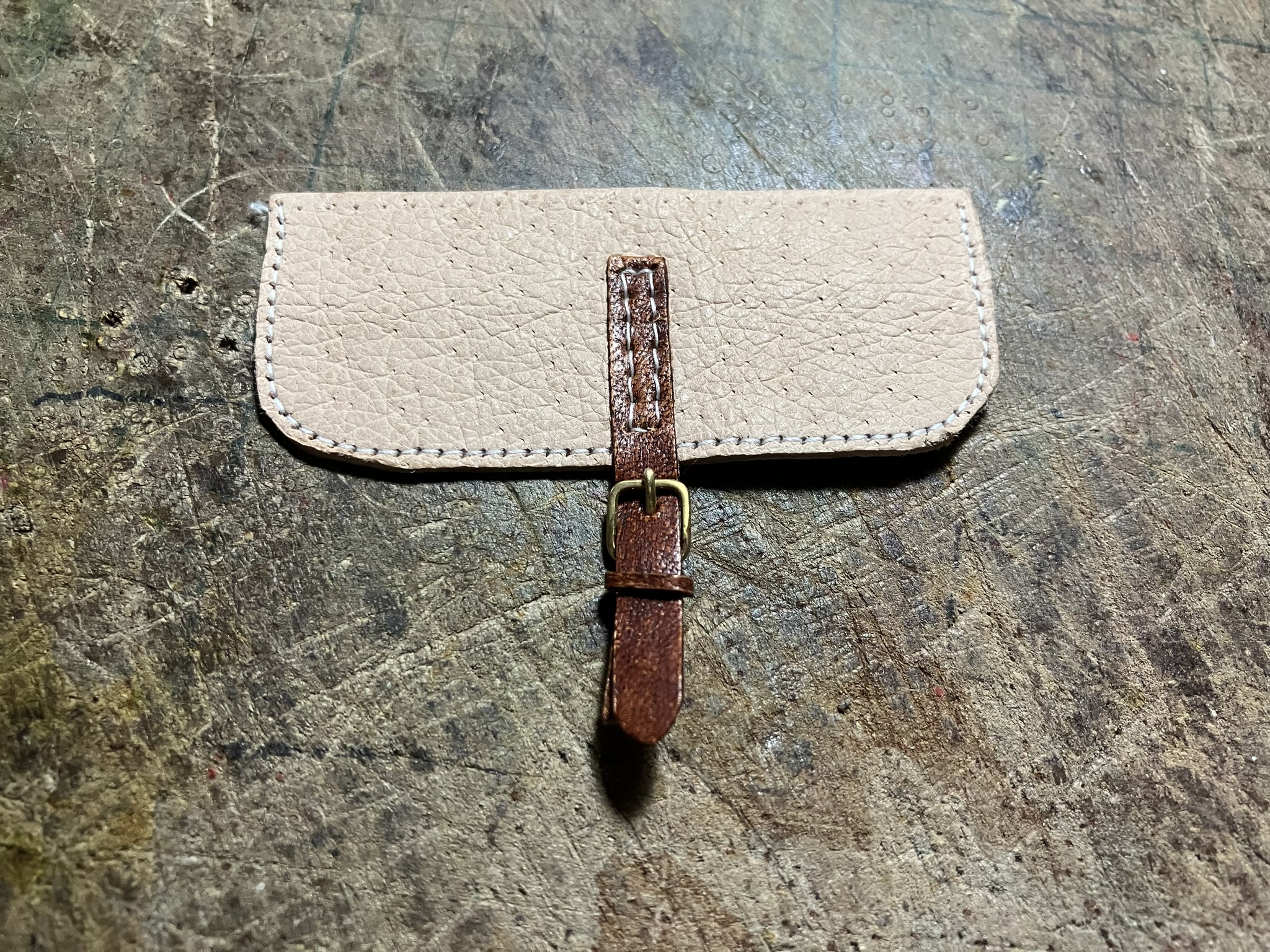
- 何か手作りしてますか?
- ペンギンの革人形を作る その199
- (2024-11-12 19:40:02)
-
-
-
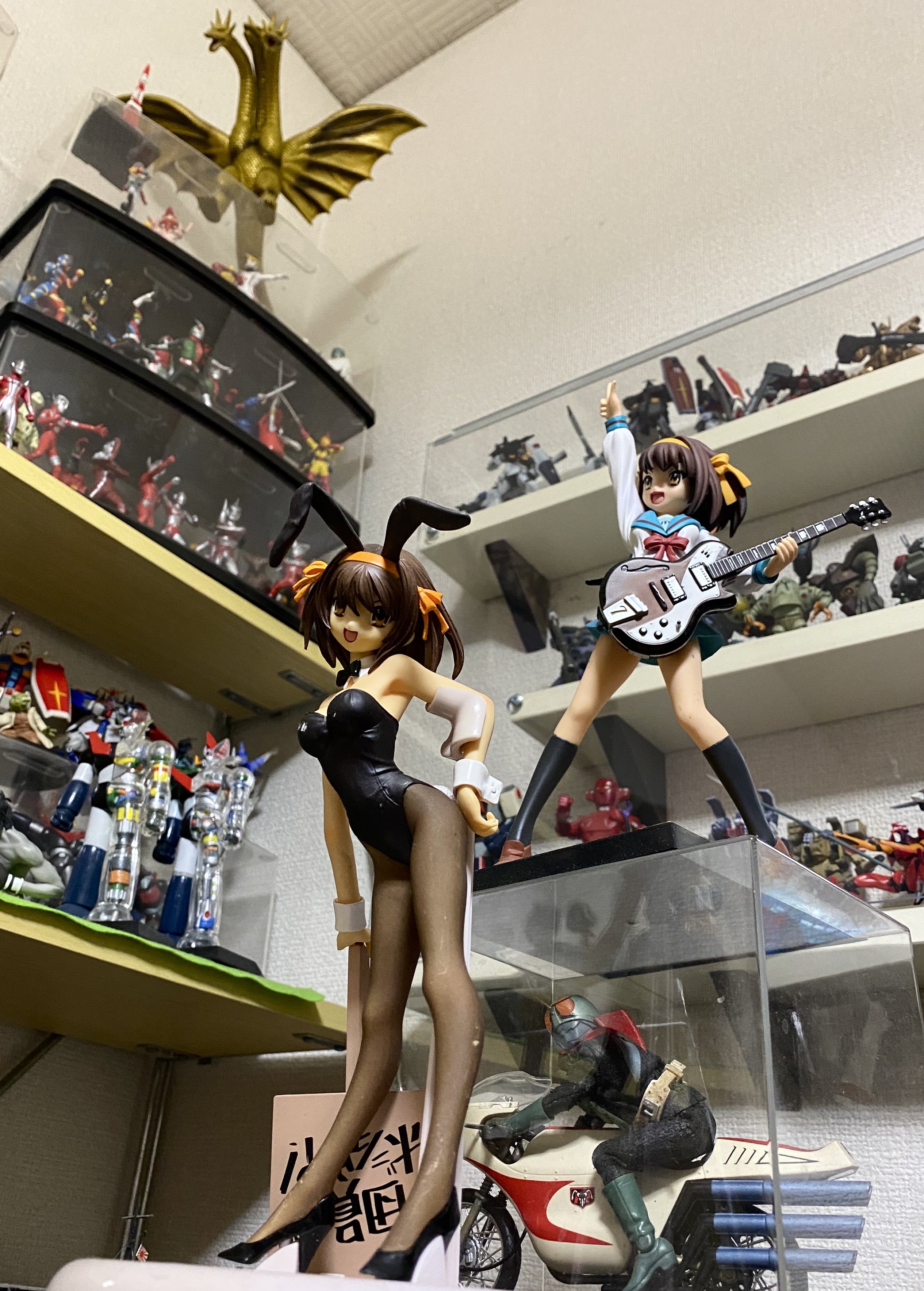
- フィギュア好き集まれ~
- もう、秋なんですね...
- (2024-11-11 16:21:41)
-






